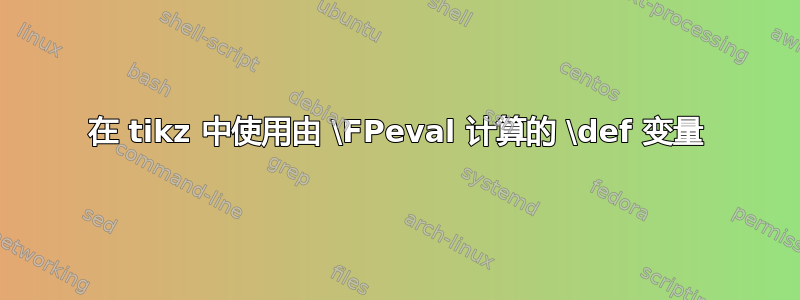
你好,我是一个绝对的初学者。
我采用了一些用于绘制神经网络的 tikz 模板并尝试对其进行修改,以便我可以自动更改层数,但它会产生奇怪的错误。
我正在使用这些包,但不知道这是否有关系
\documentclass{article}
\usepackage[utf8]{inputenc}
\usepackage[czech]{babel}
\usepackage[margin=2cm, a4paper]{geometry}
\usepackage[T1]{fontenc}
\usepackage{fontawesome}
\usepackage{xcolor}
\usepackage{graphicx}
\usepackage{array}
\usepackage[protrusion,expansion]{microtype}
\usepackage{tikz}
\usepackage[nomessages]{fp}
我在一个单独的 .sty 文件中想出了以下宏:
\newcommand{\mln}[3]{
\def\layersep{#1}
\def\inpneuroncount{#2}
\def\hidneuroncount{#3}
\FPeval{result}{clip((\hidneuroncount-\inpneuroncount)/2)}
\def\nodeoffset{yshift=\result cm}
\nodeoffset
\begin{tikzpicture}[shorten >=1pt,->,draw=black!50, node distance=\layersep]
\tikzstyle{every pin edge}=[<-,shorten <=3pt]
\tikzstyle{neuron}=[circle,fill=black!25,minimum size=15pt,inner sep=0pt]
\tikzstyle{input neuron}=[neuron, fill=green!50];
\tikzstyle{output neuron}=[neuron, fill=red!50];
\tikzstyle{hidden neuron}=[neuron, fill=blue!50];
\tikzstyle{annot} = [text width=4em, text centered]
% Draw the input layer nodes
\foreach \name / \y in {1,...,\inpneuroncount}
% This is the same as writing \foreach \name / \y in {1/1,2/2,3/3,4/4}
\node[input neuron, pin=left:Input \#\y] (I-\name) at (0,-\y) {};
% Draw the hidden layer nodes
\foreach \name / \y in {1,...,\hidneuroncount}
\path[\nodeoffset]
node[hidden neuron] (H-\name) at (\layersep,-\y cm) {};
% Draw the output layer node
\node[output neuron,pin={[pin edge={->}]right:Output}, right of=H-1] (O) {};
% Connect every node in the input layer with every node in the
% hidden layer.
\foreach \source in {1,...,\inpneuroncount}
\foreach \dest in {1,...,\hidneuroncount}
\path (I-\source) edge (H-\dest);
% Connect every node in the hidden layer with the output layer
\foreach \source in {1,...,\hidneuroncount}
\path (H-\source) edge (O);
% Annotate the layers
\node[annot,above of=H-1, node distance=1cm] (hl) {Hidden layer};
\node[annot,left of=hl] {Input layer};
\node[annot,right of=hl] {Output layer};
\end{tikzpicture}
% End of code
}
我现在想做的是让隐藏层的 yshift 等于输入神经元数量和隐藏层神经元数量之差的一半。我创建了一个变量 \nodeoffset,使用后,当您使用 \mln{2.5cm}{2}{3} 时,它会清楚地呈现文本“yshift=0.5cm”
当我尝试在部分中使用它时
% Draw the hidden layer nodes
\foreach \name / \y in {1,...,\hidneuroncount}
\path[\nodeoffset]
它会产生错误,例如“包 pgfkeys 错误:我不知道键‘/tikz/yshift=0.5cm’,我将忽略它。也许你拼写错误了。”
我如何正确获取那里的参数?
答案1
您正面临所谓的扩展问题。Ti钾Z 不会完全展开宏\nodeoffset。您可以通过替换来展开它
\path[\nodeoffset] node[hidden neuron] (H-\name) at (\layersep,-\y cm) {};
经过
\path[style/.expanded=\nodeoffset] node[hidden neuron] (H-\name) at (\layersep,-\y cm) {};
完整示例:
\documentclass{article}
\usepackage{tikz}
\usepackage[nomessages]{fp}
\newcommand{\mln}[3]{
\def\layersep{#1}
\def\inpneuroncount{#2}
\def\hidneuroncount{#3}
\FPeval{result}{clip((\hidneuroncount-\inpneuroncount)/2)}
\def\nodeoffset{yshift=\result cm}
\nodeoffset
\begin{tikzpicture}[shorten >=1pt,->,draw=black!50, node distance=\layersep]
\tikzstyle{every pin edge}=[<-,shorten <=3pt]
\tikzstyle{neuron}=[circle,fill=black!25,minimum size=15pt,inner sep=0pt]
\tikzstyle{input neuron}=[neuron, fill=green!50];
\tikzstyle{output neuron}=[neuron, fill=red!50];
\tikzstyle{hidden neuron}=[neuron, fill=blue!50];
\tikzstyle{annot} = [text width=4em, text centered]
% Draw the input layer nodes
\foreach \name / \y in {1,...,\inpneuroncount}
% This is the same as writing \foreach \name / \y in {1/1,2/2,3/3,4/4}
\node[input neuron, pin=left:Input \#\y] (I-\name) at (0,-\y) {};
% Draw the hidden layer nodes
\foreach \name / \y in {1,...,\hidneuroncount}
\path[style/.expanded=\nodeoffset]
node[hidden neuron] (H-\name) at (\layersep,-\y cm) {};
% Draw the output layer node
\node[output neuron,pin={[pin edge={->}]right:Output}, right of=H-1] (O) {};
% Connect every node in the input layer with every node in the
% hidden layer.
\foreach \source in {1,...,\inpneuroncount}
\foreach \dest in {1,...,\hidneuroncount}
\path (I-\source) edge (H-\dest);
% Connect every node in the hidden layer with the output layer
\foreach \source in {1,...,\hidneuroncount}
\path (H-\source) edge (O);
% Annotate the layers
\node[annot,above of=H-1, node distance=1cm] (hl) {Hidden layer};
\node[annot,left of=hl] {Input layer};
\node[annot,right of=hl] {Output layer};
\end{tikzpicture}
% End of code
}
\begin{document}
\mln{8em}{5}{4}
\end{document}
不过,我想建议一些修改/改进。
\tikzstyle已被弃用,请改用相应的\tikzset语法(见下文)。- 您实际上不需要
fp这里。 - 使用
positioning。 - 开头的“ s
\def”似乎没有什么目的。
还有很多事情可以改变,但这是一个部分修改的版本。
\documentclass{article}
\usepackage{tikz}
\usetikzlibrary{positioning}
\newcommand{\mln}[3]{
\begin{tikzpicture}[shorten >=1pt,->,draw=black!50, node distance=#1]
\tikzset{every pin edge/.style={<-,shorten <=3pt},
neuron/.style={circle,fill=black!25,minimum size=15pt,inner
sep=0pt},
input neuron/.style={neuron, fill=green!50},
output neuron/.style={neuron, fill=red!50},
hidden neuron/.style={neuron, fill=blue!50},
annot/.style={text width=4em, text centered},
my offset/.style={yshift={((#3-#2)/2)*1cm}}}
\begin{scope}[local bounding box=diag]
% Draw the input layer nodes
\foreach \name / \y in {1,...,#2}
% This is the same as writing \foreach \name / \y in {1/1,2/2,3/3,4/4}
\node[input neuron, pin={[alias=auxI]left:Input \#\y}] (I-\name) at (0,-\y) {};
% Draw the hidden layer nodes
\foreach \name / \y in {1,...,#3}
{\path[my offset]
node[hidden neuron] (H-\name) at (#1,-\y cm) {};}
% Draw the output layer node
\node[output neuron,pin={[pin edge={->},alias=auxO]right:Output}, right=of H-1] (O) {};
% Connect every node in the input layer with every node in the
% hidden layer.
\foreach \source in {1,...,#2}
\foreach \dest in {1,...,#3}
\path (I-\source) edge (H-\dest);
% Connect every node in the hidden layer with the output layer
\foreach \source in {1,...,#3}
\path (H-\source) edge (O);
\end{scope}
% Annotate the layers
\path ([yshift=1ex]diag.north-|H-1.center) node[anchor=south,annot] (hl) {Hidden layer};
\path ([yshift=1ex]diag.north-|auxI.west) node[anchor=south west,annot] {Input layer};
\path ([yshift=1ex]diag.north-|auxO.east) node[anchor=south east,annot] {Output layer};
\end{tikzpicture}
% End of code
}
\begin{document}
\mln{8em}{5}{4}
\end{document}



